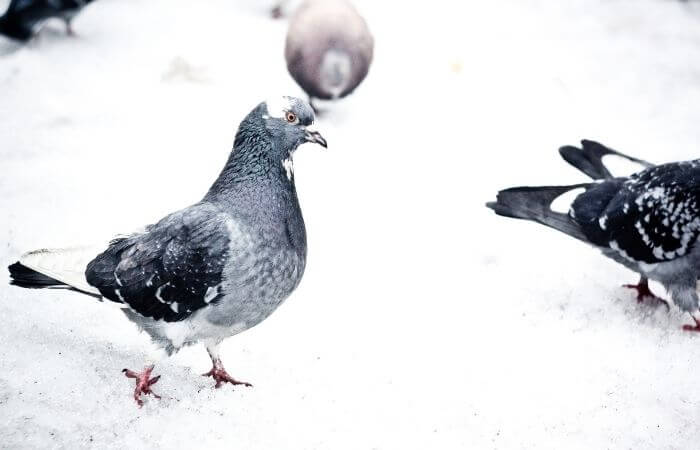Pigeons can be found all around the world and are able to tolerate a vast range of environmental and climatic conditions.
Pigeons can tolerate temperatures below zero (Celcius) with ease.

That said ideally your pigeons should be kept in temperatures between 10 and 20 degrees C, with humidity below 60.
As an Amazon Associate I earn a small fee from qualifying purchases made through Amazon links. This helps us run the site – thanks for your support!
If you are new to keeping pigeons you should know that in the cold winter months you should keep them warm with a heat lamp or heat pad to avoid them getting any frostbite in their feet.
Don’t worry if you don’t have one as their feathers trap a lot of air which keeps them surprisingly warm regardless of the weather.
There Are No Pigeons In The Arctic
The common pigeon is part of the extended Columbidae scientific family that includes well over 300 types of bird, all related to each other in one form or another.
They can be found in practically every part of the globe.

The only places that they won’t be found are in the Sahara Desert because of the extreme heat, and the Arctic and Antarctica because of the extreme cold.
This also includes the tip of South America.
The Arctic polar region registers regular temperatures of minus 40 degrees Celsius during the coldest months, this is definitely too cold for pigeons.
The Arctic Circle comprises the northern parts of the U.S.A, Canada, Greenland, Iceland, Norway Sweden, Finland, and Russia.
There Are No Pigeons In The Extreme South
Antarctica is even worse with temperatures between minus 80 to 89 degrees Celsius.
So you can see that even the hardy pigeon that dares to go anywhere, wouldn’t survive such low temperatures.
The Arctic cycle starts at the end of the treeline, so beyond that they wouldn’t find enough food resources anyway, forget Antarctica!
Only specially adapted animals can survive in those kinds of climates.
According to scientists, the Arctic Circle is shrinking because of climate change, so maybe one day the intrepid pigeon will venture further north when temperatures rise.
Pigeons In Milder Climates

South of the Arctic Circle, the temperatures aren’t so extreme, but can still be bitterly cold. Wind chill factors can push down temperatures to levels not normally seen for periods of time.
Over the last decade record lows have been registered in Europe.
Despite these extremes, the pigeon population hasn’t fallen.
In fact, their numbers are still rising. How do they do it?
Domestic Pigeons
Domesticated pigeons will have no worries.
Owners of exotic breeds will probably keep them inside during the worst winter months or have sufficiently sheltered roosts where they can provide some artificial heating like air blowers to warm up the air enough so they don’t suffer extreme cold.
Other pigeon fanciers such as racing pigeon enthusiasts will do the same for their flock in their lofts. So, what about all those feral pigeons?
Feral Pigeons
Woodland pigeons that live in the rural countryside, just have to take their chances.
Those inner-city feral pigeons may have an advantage when it comes to staving off the cold.

Cities and towns are always warmer than the rural areas because the accumulated heat built up through traffic and millions of heating systems.
Of course, the coldest hours are during the night, but residue heat still lingers in the buildings on which pigeons roost.
Also the pigeon’s habit of roosting side by side for protection against predators and warmth, sharing body heat, helps them even in the coldest months.
Pigeons Feathers Keep Them Warm
Their plumage is what helps pigeons generate and retain essential body heat.
When you look at a pigeon they seem small and compact creatures. In fact, they look pretty sleek.
Fortunately for them, their feathers provide a dense body coverage.
Their bases, where they emerge from the skin are thick with fluffy filaments.

Pigeons will puff out their feathers and contract them to trap air or resort to ‘shivering’ to generate heat.
This helps trap and warm the air between the feathers, retaining body heat.
Pigeon Popsicles
Not much is known about at what point a pigeon would freeze to death.
You can take 40 minus Celsius as a benchmark and guess at what degree below zero that a pigeon turns into a popsicle.
One experiment has taken place where pigeons were subjected to low degrees of temperature.
It was an attempt to measure the cold vs feeding ratio of pigeons. The lowest temperature was less than one degree Celsius.
Maybe some nutter has actually experimented with freezing pigeons in the name of scientific research, but those facts aren’t widely known.
What is known is that pigeons are intelligent birds and great survivors.
It is doubtful that they would hang around anywhere that extreme temperatures would harm them.

This article was written by our qualified veterinarian Cristina.
This is part of our commitment to providing you with the most trustworthy veterinary advice for your pigeons.
Sources:
